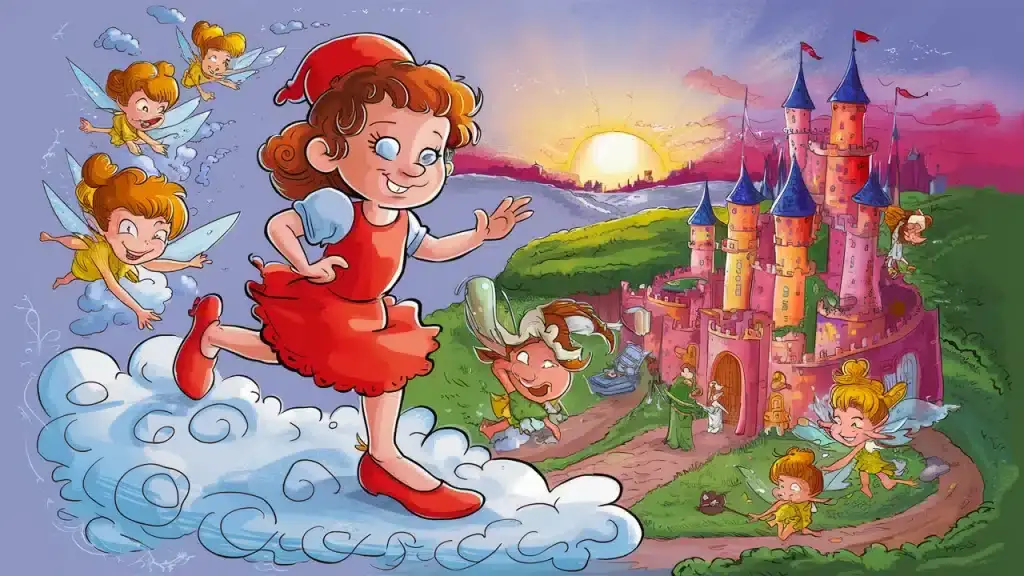The Red Shoes Fairytale . Once upon a time, in the world of fairy tales, there was a captivating story called “The Red Shoes.” Written by Hans Christian Andersen, this tale dives deep into themes of obsession, vanity, and the costly lessons of life.

In “The Red Shoes,” readers meet a poor girl named Karen, who becomes infatuated with a pair of shiny red shoes. This obsession leads her down a path of regret and suffering.
“The Red Shoes” offers a unique blend of fantasy and moral teaching, making it a timeless literary gem.
In this tale, Andersen explores themes like temptation and redemption, drawing from European folklore traditions. His other famous literary works include “The Elf Mound,” “The Jumpers,” and “The Shepherdess and the Chimney Sweep.”
Throughout the story, Karen’s struggle with her desire for the red shoes becomes a powerful metaphor for the consequences of unchecked greed and pride. For those interested in literary fairy tales that offer more than just entertainment, “The Red Shoes” stands out as a tale that imparts a lasting moral lesson wrapped in enchanted storytelling.
Origins and Authorship

The Red Shoes” is a captivating tale written by Hans Christian Andersen. Originating from Denmark, this story delves into the consequences of succumbing to temptation and vanity.
The Red Shoes Fairytale : Creation by Andersen
Hans Christian Andersen, a Danish author, created “The Red Shoes” as part of his collection of new fairy tales. He crafted the tale during the mid-19th century in Copenhagen.
The story combines Christian morality with a rich narrative, showcasing Andersen’s unique storytelling style.
The tale’s moral themes and engaging narrative led to its republication in various languages and formats. Over time, it became a classic, influencing many adaptations, including films, novels, and dance performances.
Publication History
“The Red Shoes” first appeared in 1845. Initially published in Denmark, the story quickly gained traction across Europe. It was included in Andersen’s collection titled Fairy Tales. 1850 and later in Fairy Tales and Stories. Second Volume. 1863.
The tale’s moral themes and engaging narrative led to its republication in various languages and formats. Over time, it became a classic, influencing many adaptations, including films, novels, and dance performances.
Plot Overview

Hans Christian Andersen’s “The Red Shoes” is a tale about a young girl named Karen. Her vanity and obsession with a pair of red shoes lead her down a path of sin, punishment, and redemption. The journey forces her to confront her mistakes under the guidance of a divine angel.
Early Life of Karen
Karen starts her life as a poor girl, finding joy in simple things. After her mother’s death, she is taken in by a wealthy old lady.
Life with her new guardian is luxurious, a stark contrast to her past. Karen’s new home provides her with fine clothes and a life of comfort, which changes her.
She becomes vain and desires beautiful things, including a pair of red shoes. Her once humble spirit is overshadowed by her new desire for beauty and attention.
The Red Shoes
One day, Karen sees a sparkling pair of red shoes and longs to have them. Ignoring the inappropriateness of wearing such shoes to church, she persuades her adoptive mother to buy them. The red shoes symbolize her growing vanity and pride.
These shoes become her prized possession. Karen wears them constantly, showing them off at every opportunity, even when it’s unfitting, like at church. This behavior marks the beginning of her downfall.
A Life of Dance
Karen’s obsession with the red shoes takes a dark turn when she wears them to a party. Once she starts dancing, she finds she cannot stop. The shoes seem to control her, forcing her to dance endlessly.
This relentless dancing becomes her punishment for her vanity and pride. Karen can’t rest, sleep, or stop. She dances through the streets, fields, and forests, exhausting her physically and emotionally.
The Angel’s Warning
In her exhausted state, Karen encounters an angel, who delivers a stern warning. The angel tells Karen that her punishment is due to her sins of vanity and ignoring her duties and responsibilities.
The angel’s warning shakes Karen to the core. She understands the grave mistake she made by placing her desires above everything else, realizing how she neglected her moral and spiritual obligations.
Redemption and Aftermath
Desperate for redemption, Karen finally decides to stand against her obsession. She seeks help from an executioner to cut off her feet along with the cursed shoes, ending her endless dance. Though free from the shoes, she faces life as an amputee.
Her suffering leads her to a path of humility and genuine repentance. Karen’s humble acceptance of her fate eventually brings her forgiveness. By the story’s end, she is spiritually redeemed and finds peace, suggesting her soul enters heaven.
Character Profiles

The characters in “The Red Shoes” each play pivotal roles in driving the tale forward. From Karen’s tragic journey to the enigmatic shoemaker’s fateful gift, let’s dive into their profiles.
Karen
Karen is the central figure of the story. A poor girl, she starts wearing shoes made from scraps. Her life changes when she gets a pair of red shoes, which she becomes obsessed with. The shoes take control of her, leading her to dance endlessly against her will. Her vanity and desire for these shoes symbolize her moral conflict and the consequences of being consumed by materialism. Throughout her ordeal, Karen learns about humility and repentance, showing her transformation from a girl obsessed with appearances to one seeking redemption.
The Old Soldier with the Red Beard
The old soldier plays a significant role as an antagonist in Karen’s story. He appears twice, each time influencing Karen’s fate. First, his red beard and mocking demeanor highlight his almost otherworldly presence. In their second encounter, he condemns Karen to dance endlessly with the cursed red shoes. His character can be seen as a symbol of fate or retribution, ensuring that Karen confronts the consequences of her actions. The soldier’s seemingly sinister role underscores the moral message of the tale.
The Enigmatic Shoemaker
The shoemaker, mysterious and almost magical, crafts the infamous red shoes. His simple act of creating these beautiful yet cursed shoes sets the entire story in motion.
While not much is revealed about him, his craftsmanship represents the allure and danger of unchecked desires. The shoes he makes are both a blessing and a curse, encapsulating the dual nature of vanity and the fine line between joy and suffering. Through the shoemaker, the story subtly addresses the hidden dangers behind what seems harmless.
Other Key Figures
- The Old Lady: She adopts Karen, giving her a chance for a better life. This character adds depth to Karen’s story by showing an initial act of kindness and shaping the start of her journey.
- The Princess: Another character who appreciates similar red shoes, highlighting the social contrast and further tempting Karen into coveting what she cannot have.
- The Angel: Serving as a symbol of divine intervention and forgiveness, the angel appears to Karen towards the end, guiding her towards repentance and ultimate redemption.
- The Executioner: In a desperate bid to stop dancing, Karen begs an executioner to cut off her feet. This gruesome yet pivotal figure demonstrates the extreme lengths Karen goes to for freedom, emphasizing the story’s dark tone.
Symbolism and Themes

Hans Christian Andersen’s “The Red Shoes” touches on deeper issues like vanity, sin, and redemption. Central symbols and motifs help convey these complex themes.
The Significance of the Red Shoes
The red shoes in Andersen’s tale are more than just footwear. They symbolize vanity and pride.
Karen, the main character, desires the shoes for their beauty. Once she wears them, she can’t stop dancing, which is a metaphor for losing control due to vanity. The shoes are cursed, representing temptation and the consequences of giving in to sinful desires.
The constant dance Karen is forced into represents how uncontrollable desires can dominate one’s life. The red color signifies not only beauty and passion but also danger and sin. The uncontrollable movement reflects how pride can lead to one’s downfall.
Religious Motifs
“The Red Shoes” contains strong Christian themes. The story uses religious symbolism to highlight the perils of giving in to temptation.
Karen’s obsession with the shoes leads her away from a righteous path, embodying the concept of sin in Christianity. She attends church but is more interested in her shoes than prayer. This behavior represents how material vanity can distract from spiritual obligations. The punishment that follows signifies divine retribution.
When Karen seeks redemption, she finds it only through sincere repentance, aligning with Christian teachings on sin and forgiveness.
Karen’s Transformation
Karen’s journey is one of transformation and realization. Initially, she is consumed by pride and vanity due to the red shoes. These traits lead her to a life of suffering.
Karen’s eventual punishment—having to dance endlessly—forces her to confront the consequences of her actions. Her desire for redemption grows, and she seeks forgiveness.
Her transformation highlights the story’s moral lesson about the dangers of unchecked vanity and the path to redemption. The harsh consequences she faces serve as a warning, while her eventual repentance shows that change and forgiveness are possible, but only through real humility and remorse.
Cultural Impact
“The Red Shoes” by Hans Christian Andersen has left an enduring legacy. This tale has inspired a variety of adaptations in film, theater, and literature.
Film and Stage Adaptations
“The Red Shoes” has spawned several notable adaptations in film and theater. The most famous is the 1948 British film directed by Michael Powell and Emeric Pressburger. This movie combined ballet with the dark themes of the original tale, leaving a lasting impression on audiences.
In addition to films, the story inspired many stage adaptations. For instance, acclaimed choreographer Matthew Bourne reimagined the tale in a ballet, keeping the story alive through dance. Bourne’s version has been performed worldwide, highlighting the story’s universal appeal and emotional depth.
Influence on Literature and Arts
The tale of “The Red Shoes” has also had a significant influence on literature and arts. Authors and artists have reinterpreted the story in various ways, exploring themes of obsession and loss of control.
Notably, the 2013 novel by John Stewart Wynne gives the story a modern twist, setting it in New York City.
Artists find inspiration in the haunting imagery of the tale. Illustrated versions often depict Karen dancing uncontrollably, a powerful symbol of addiction and obsession. These visual elements contribute to the story’s lasting impact on popular culture.
“The Red Shoes” has inspired musicians too. It served as an inspiration for Kate Bush’s album of the same name, showcasing its influence across different artistic disciplines.
By weaving its themes into various forms of media, “The Red Shoes” continues to captivate and inspire those who encounter it.
Moral Lessons and Interpretations
The Red Shoes fairy tale by Hans Christian Andersen offers rich moral teachings and a deep exploration of themes like sin, vanity, and the path to redemption.
Lessons on Morality and Virtue
The story of The Red Shoes is laced with lessons on morality. Karen, the main character, becomes obsessed with her beautiful red shoes, letting vanity cloud her judgment.
Her need for the shoes leads her astray, impacting her actions and priorities.
Karen’s transformation points to the importance of maintaining a moral compass. Her story reminds readers of the danger of letting superficial desires override one’s ethical values.
In the end, Karen learns the hard way about the importance of humility and virtue.
Interpretations of Sin and Vanity
Karen’s fixation on the red shoes is often interpreted as a representation of sin. In a Christian context, vanity is viewed as a sinful distraction from what is truly important in life.
Karen’s shoes symbolize a selfish longing that leads her away from moral righteousness.
This obsession drives Karen to sinful behavior. Her vanity results in her inability to control her actions, leading her to dance uncontrollably.
This spiraling loss of control serves as a metaphor for how sin can take hold and dominate a person’s life, causing pain and sorrow.
Consequences and Redemption
Karen’s journey showcases the harsh consequences of her vanity. The enchanted shoes make her dance endlessly, forcing her to confront the pain her actions cause.
This relentless ordeal emphasizes the severe consequences of straying from one’s ethical path.
Yet, redemption is a key element in her story. Karen’s eventual repentance and the recognition of her wrongdoings bring her a form of spiritual healing.
By devoting herself to penance and seeking forgiveness, she finds peace.
In her final moments, Karen’s transformed heart and sincere remorse signal that redemption is possible, but it often comes at a great cost. This narrative reinforces the importance of making amends and seeking to realign with moral values after straying off course.
Key Literary Devices and Writing Style
Hans Christian Andersen’s “The Red Shoes” showcases rich symbolism, vivid imagery, and unique storytelling techniques. Discover how he uses these elements to create an unforgettable fairy tale experience.
Use of Symbolism
Andersen uses symbolism to convey deeper meanings and moral lessons. The red shoes themselves are a powerful symbol of vanity and desire. They represent Karen’s obsession and the consequences of letting such desires control her.
This story shows how something as simple as a pair of shoes can lead to a person’s downfall. Andersen’s use of symbolism helps readers grasp universal truths and adds a layer of depth to the fairy tale.
Andersen’s Imagery
Imagery plays a crucial role in bringing the story to life. Andersen paints vivid pictures of Karen dancing uncontrollably in the red shoes.
His detailed descriptions make the reader feel as if they are witnessing the events unfold.
From the glitter of the shoes to the torment Karen feels, Andersen’s imagery is both beautiful and haunting. It helps create a strong emotional connection between the reader and the characters.
Storytelling Techniques
Andersen’s narrative style is straightforward yet engaging. He uses a third-person point of view, which gives the reader a broad perspective on the characters and events. This allows him to weave in moral lessons without sounding preachy.
His use of repetition, especially in describing Karen’s relentless dancing, amplifies the story’s impact. The simple language and clear plot make it accessible, while the underlying themes keep readers thinking long after the story ends.
External Allusions and Historical Context
Hans Christian Andersen’s “The Red Shoes” is rich with cultural references and historical context. This fairy tale touches on themes relevant to 19th-century Danish society and has influenced various works over time.
References in Other Works
“The Red Shoes” has inspired numerous adaptations and references in other media. For instance, the 1948 film directed by Michael Powell and Emeric Pressburger takes the essence of Andersen’s tale and weaves it into a ballet-centric narrative.
Alice Munro’s short story “The Time of Death” subtly nods to the same tale, incorporating its themes without direct mentions. There’s even a flamenco adaptation choreographed by Olivia Chacon, bringing a unique cultural twist to the story.
These adaptations highlight how Andersen’s story travels across different art forms and eras, maintaining its core themes while adapting to new audiences.
Historical Significance
The historical backdrop of “The Red Shoes” is crucial. Written in 1845, this period was marked by significant changes in Europe, like industrialization and shifts in social norms.
Andersen, living in Denmark, was influenced by these transformations. His tale often reflects societal views on morality and punishment.
In the context of 19th-century Danish culture, red shoes symbolize both desire and sin. The tale warns against vanity and the consequences of succumbing to temptation, which were common moral themes during the Victorian era.
Contextual Influence on the Tale
Andersen’s personal experiences also shaped “The Red Shoes.” He grew up poor and faced numerous hardships, which often influenced his storytelling.
His empathy for the struggles of the lower class is evident in the tale of Karen, the orphan girl whose vanity leads to her downfall.
Plus, Andersen’s Danish roots are sprinkled throughout the story. The village settings, the old shoemaker, and other elements draw directly from his experiences and observations of Danish life.
This connection adds a layer of authenticity and cultural richness to the tale, making it resonate with readers from his era and beyond.
“The Red Shoes” remains a powerful example of how personal and cultural influences can shape storytelling, leaving a lasting impact across generations.
For a detailed analysis of the narrative and its implications, check out this summary and analysis of ‘The Red Shoes’.
Steve is the creative force behind Unique Tales, a blog dedicated to sharing captivating stories that explore the human experience in all its complexity. With a passion for writing and a talent for crafting engaging narratives, Steve's blog is a treasure trove of imaginative tales that transport readers to other worlds and challenge them to see things from new perspectives. From epic adventures to intimate character studies, Steve's stories are always thought-provoking and emotionally resonant. With a growing following of readers who appreciate his unique voice and creative vision, Steve is quickly becoming a rising star in the world of online storytelling.






